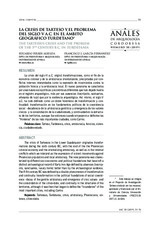Mostrar el registro sencillo del ítem
La crisis de Tarteso y el problema del siglo V a.C. en el ámbito geográfico turdetano
| dc.contributor.author | Ferrer Albelda, Eduardo | |
| dc.contributor.author | García Fernández, Francisco J. | |
| dc.date.accessioned | 2020-02-12T09:18:16Z | |
| dc.date.available | 2020-02-12T09:18:16Z | |
| dc.date.issued | 2019 | |
| dc.identifier.issn | 1130-9741 | |
| dc.identifier.uri | http://hdl.handle.net/10396/19539 | |
| dc.description.abstract | La crisis del siglo VI a.C. originó transformaciones, como el fin de la economía colonial y de la aristocracia orientalizante, precipitadas por conflictos internos interpretados como la expresión de movimientos contra la población fenicia y la aristocracia local. El nuevo panorama se caracteriza por unas bases sociopolíticas y económicas diferentes que han dejado huella en el registro arqueológico, más por sus ausencias (necrópolis, santuarios, artesanía de lujo) que por la evidencia arqueológica. Así mismo, el siglo V a.C. ha sido definido como un doble fenómeno de transformación y continuidad: transformación en los fundamentos políticos de la coexistencia social –decadencia de la aristocracia gentilicia y emergencia de los valores cívicos– y la consolidación de la ciudad-estado, y continuidad en la estructura de los territorios, aunque fue entonces cuando empezaron a definirse las “fronteras” de las más importantes ciudades, como Carmo. | es_ES |
| dc.description.abstract | The crisis of Tartessos in the Lower Guadalquivir originates transformations during the sixth century BC, with the end of the the Phoenician colonial economy and the orientalizing aristocracy, as well as in the internal conflicts which we interpret as the expression of violent movements against Phoenician population and local aristocracy. The new panorama was characterized by different socio-economic and political foundations that have left a distinct archaeological record of Early Iron Age defined by absences (necropolis, sanctuaries, luxury items) better than by the archaeological evidence. The Fifth century BC was defined by a double phenomenon of transformation and continuity: transformation in the political foundations of social coexistence –decay of the gentile aristocracy and emergence of civic values– and the consolidation of the cities-state, and continuity in the structures of the territories, although it was then that began to define the “boundaries” of the most important cities, including Carmo. | es_ES |
| dc.format.mimetype | application/pdf | es_ES |
| dc.language.iso | spa | es_ES |
| dc.publisher | Universidad de Córdoba, Área de Arqueología | es_ES |
| dc.rights | https://creativecommons.org/licenses/by/3.0/ | es_ES |
| dc.source | Anales de Arqueología Cordobesa 30, 51-76 (2019) | es_ES |
| dc.subject | Tartesos | es_ES |
| dc.subject | Turdetania | es_ES |
| dc.subject | Crisis | es_ES |
| dc.subject | Aristocracia | es_ES |
| dc.subject | Fenicios | es_ES |
| dc.subject | Violencia | es_ES |
| dc.subject | Ciudades-estado | es_ES |
| dc.subject | Tartessus | es_ES |
| dc.subject | Aristocracy | es_ES |
| dc.subject | Phoenicians | es_ES |
| dc.subject | Violence | es_ES |
| dc.subject | Cities-state. | es_ES |
| dc.title | La crisis de Tarteso y el problema del siglo V a.C. en el ámbito geográfico turdetano | es_ES |
| dc.title.alternative | The Tartessus crisis and the problem of the 5th century b.C. in Turdetania | es_ES |
| dc.type | info:eu-repo/semantics/article | es_ES |
| dc.relation.publisherversion | https://www.uco.es/ucopress/ojs/index.php/anarcor/index | es_ES |
| dc.rights.accessRights | info:eu-repo/semantics/openAccess | es_ES |

